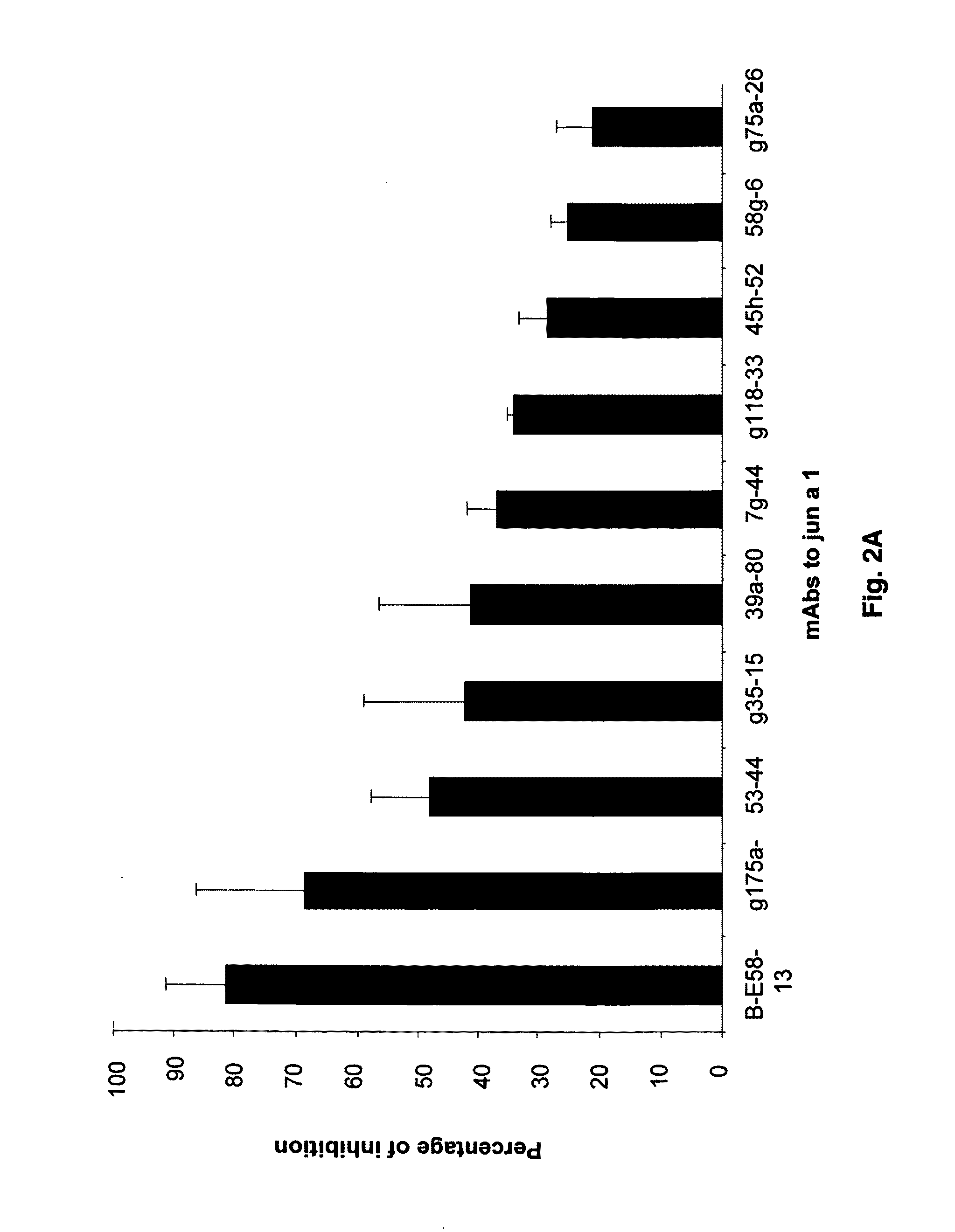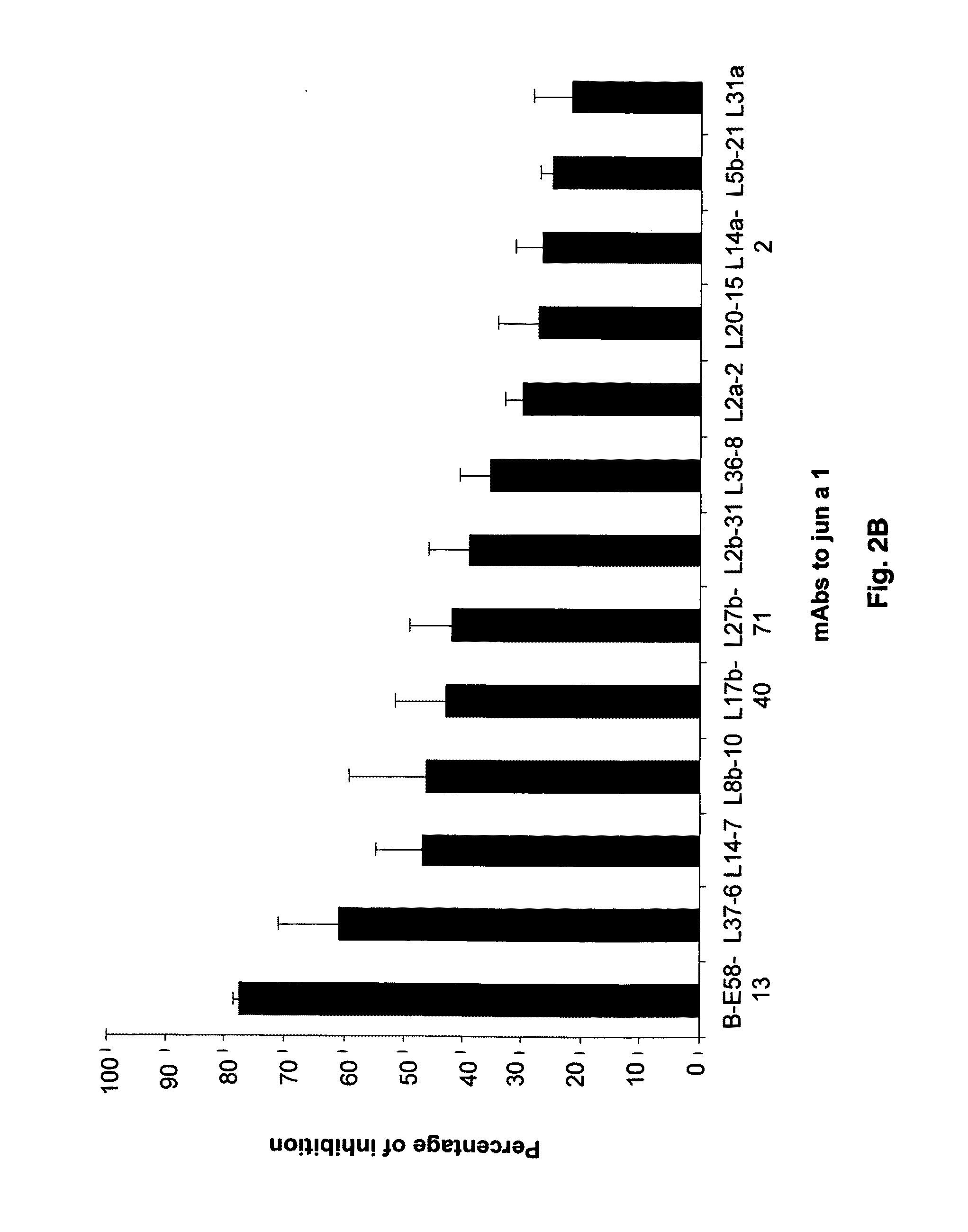Antibody-mediated modulation of allergy
an antibody-mediated modulation and allergy technology, applied in the field of immunology and allergology, can solve the problems of increased health care costs, increased morbidity, and loss of productivity, and achieve the effect of preventing the development of an allergic reaction to pollen in an individual
- Summary
- Abstract
- Description
- Claims
- Application Information
AI Technical Summary
Benefits of technology
Problems solved by technology
Method used
Image
Examples
example 1
Identification and Characterization of Anti-Allergen Monoclonal Antibody
[0078]Previous studies had identified two major allergens. One of them, Jun a 1 has an amino acid and nucleic acid sequence shown in SEQ ID NOS: 1 and 2, respectively (21). The other, Jun a 3 has an amino acid and nucleic acid a nucleic acid and an amino acid sequence shown in SEQ ID NOS: 3 and 4, respectively.
[0079]Screening of a large panel of anti-Jun a 1 monoclonal antibodies by grouping assay led to an anomalous inhibition pattern exhibited by one of the monoclonal antibodies. Briefly, the grouping assays are based on the concept that two monoclonal antibodies that react with the same or spatially close regions of a protein will inhibit the binding of each other to that protein. While none of the 21 antibodies inhibited the binding of E58 monoclonal antibody to Jun a 1, E58 monoclonal antibody when added to Jun a 1 first inhibited>30% of the binding of the 16 of these antibodies to Jun a 1 (FIGS. 2A-2B).
[00...
example 2
Production of Engineered, High Affinity Versions of E58 and their Ability in Suppressing Jun a 1's Ability to Bind Human IgE Antibodies
[0082]The present invention contemplates using APEx (Antibody enhancement technology) to produce high affinity versions of E58. Briefly, the APEx method involves 1) anchoring an antibody of interest, usually in the form of a single chain containing both variable region fragments (scFv), to the outer surface of the E. coli inner membrane, 2) removal of the outer membrane with lysozyme / detergent to produce spheroplasts which are covered with the now-exposed antibodies, 3) incubation of the antibody-displaying spheroplasts with limiting amounts of fluorescently labeled antigen, and 4) isolation of spheroplasts displaying active Abs using fluorescence activated cell sorting (FACS). Anchoring to the outer surface of the inner membrane is achieved by fusing the antibody fragment to an NIpA anchoring sequence that is fatty acylated in vivo. This approach ha...
example 3
Inhibition of Activation of Cultured Mast Cells and Blood Basophils Sensitized with Human IgE Antibodies and Exposed to Purified Jun a1 Allergen
[0086]Mast cells and basophils are the major cell types that mediate the allergic reactions after cross-linking of their FcER1 by IgE Ab-allergen complexes. Based on the activity of E58 in ELISA assays (FIG. 3), the binding of specifically engineered E58 to Jun a 1 should substantially reduce Jun a 1′ s ability to cross-link patient IgE attached to the FcER1 on the surface of mast cells and basophils, thereby preventing the Jun a 1-induced release of allergic mediators. Increased affinity and perhaps subtle changes in the epitope recognized on Jun a 1 should enhance the effectiveness of the engineered, relative to native E58.
[0087]This concept is tested using cultured mast cells transfected with a plasmid expressing human FcER1 alpha chain (23; RBL-SX 38, Dr. J. P. Kinet, Harvard Medical School). These cells are incubated overnight with sera...
PUM
| Property | Measurement | Unit |
|---|---|---|
| structures | aaaaa | aaaaa |
| concentrations | aaaaa | aaaaa |
| concentration | aaaaa | aaaaa |
Abstract
Description
Claims
Application Information
 Login to View More
Login to View More - R&D
- Intellectual Property
- Life Sciences
- Materials
- Tech Scout
- Unparalleled Data Quality
- Higher Quality Content
- 60% Fewer Hallucinations
Browse by: Latest US Patents, China's latest patents, Technical Efficacy Thesaurus, Application Domain, Technology Topic, Popular Technical Reports.
© 2025 PatSnap. All rights reserved.Legal|Privacy policy|Modern Slavery Act Transparency Statement|Sitemap|About US| Contact US: help@patsnap.com



